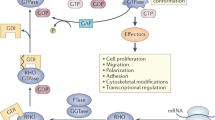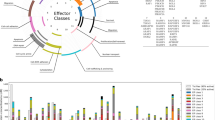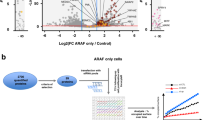Abstract
We characterized differential gene expression profiles of fibroblast cell lines harboring single or double-homozygous null mutations in H-ras and N-ras. Whereas the expression level of the individual H-, N- and K-ras genes appeared unaffected by the presence or absence of the other ras loci, significant differences were observed between the expression profiles of cells missing N-ras and/or H-ras. Absence of N-ras produced much stronger effects than absence of H-ras over the profile of the cellular transcriptome. N-ras−/− and H-ras−/− fibroblasts displayed rather antagonistic expression profiles and the transcriptome of H-ras−/− cells was significantly closer to that of wild-type fibroblasts than to that of N-ras−/− cells. Classifying all differentially expressed genes into functional categories suggested specific roles for H-Ras and N-Ras. It was particularly striking in N-ras−/− cells the upregulation of a remarkable number of immunity-related genes, as well as of several loci involved in apoptosis. Reverse-phase protein array assays demonstrated in the same N-ras−/− cells the overexpression and nuclear migration of tyrosine phosphorylated signal transducer and activator of transcription 1 (Stat1) which was concomitant with transcriptional activation mediated by interferon-stimulated response elements. Significantly enhanced numbers of apoptotic cells were also detected in cultures of N-ras−/− cells. Our data support the notion that different Ras isoforms play functionally distinct cellular roles and indicate that N-Ras is significantly involved in immune modulation/host defense and apoptotic responses
This is a preview of subscription content, access via your institution
Access options
Subscribe to this journal
Receive 50 print issues and online access
$259.00 per year
only $5.18 per issue
Buy this article
- Purchase on Springer Link
- Instant access to full article PDF
Prices may be subject to local taxes which are calculated during checkout






Similar content being viewed by others
References
Barash Y, Dehan E, Krupsky M, Franklin W, Geraci M, Friedman N et al. (2004). Comparative analysis of algorithms for signal quantitation from oligonucleotide microarrays. Bioinformatics 20: 839–846.
Beadling C, Guschin D, Witthuhn BA, Ziemiecki A, Ihle JN, Kerr IM et al. (1994). Activation of JAK kinases and STAT proteins by interleukin-2 and interferon alpha, but not the T cell antigen receptor, in human T lymphocytes. EMBO J 13: 5605–5615.
Benjamini Y, Drai D, Elmer G, Kafkafi N, Golani I . (2001). Controlling the false discovery rate in behavior genetics research. Behav Brain Res 125: 279–284.
Bollag G, McCormick F . (1991). Differential regulation of rasGAP and neurofibromatosis gene product activities. Nature 351: 576–579.
Bolstad BM, Irizarry RA, Astrand M, Speed TP . (2003). A comparison of normalization methods for high density oligonucleotide array data based on variance and bias. Bioinformatics 19: 185–193.
Bos JL . (1989). ras oncogenes in human cancer: a review. Cancer Res 49: 4682–4689.
Brem R, Certa U, Neeb M, Nair AP, Moroni C . (2001). Global analysis of differential gene expression after transformation with the v-H-ras oncogene in a murine tumor model. Oncogene 20: 2854–2858.
Clyde-Smith J, Silins G, Gartside M, Grimmond S, Etheridge M, Apolloni A et al. (2000). Characterization of RasGRP2, a plasma membrane-targeted, dual specificity Ras/Rap exchange factor. J Biol Chem 275: 32260–32267.
Colicelli J . (2004). Human RAS superfamily proteins and related GTPases. Sci STKE 2004: RE13.
Croonquist PA, Linden MA, Zhao F, Van Ness BG . (2003). Gene profiling of a myeloma cell line reveals similarities and unique signatures among IL-6 response, N-ras-activating mutations, and coculture with bone marrow stromal cells. Blood 102: 2581–2592.
Davies SA, Houslay MD, Wakelam MJ . (1989). The effects of p21N-ras expression in NIH-3T3 cells upon cyclic AMP metabolism. Biochim Biophys Acta 1013: 173–179.
de Castro IP, Diaz R, Malumbres M, Hernandez MI, Jagirdar J, Jimenez M et al. (2003). Mice deficient for N-ras: impaired antiviral immune response and T-cell function. Cancer Res 63: 1615–1622.
Dumaz N, Marais R . (2005). Integrating signals between cAMP and the RAS/RAF/MEK/ERK signalling pathways. Based on the anniversary prize of the Gesellschaft fur Biochemie und Molekularbiologie Lecture delivered on 5 July 2003 at the Special FEBS Meeting in Brussels. FEBS J 272: 3491–3504.
Ehrhardt A, David MD, Ehrhardt GR, Schrader JW . (2004). Distinct mechanisms determine the patterns of differential activation of H-Ras, N-Ras, K-Ras 4B, and M-Ras by receptors for growth factors or antigen. Mol Cell Biol 24: 6311–6323.
Eskandarpour M, Kiaii S, Zhu C, Castro J, Sakko AJ, Hansson J . (2005). Suppression of oncogenic NRAS by RNA interference induces apoptosis of human melanoma cells. Int J Cancer 115: 65–73.
Espina V, Mehta AI, Winters ME, Calvert V, Wulfkuhle J, Petricoin EF et al. (2003). Protein microarrays: molecular profiling technologies for clinical specimens. Proteomics 3: 2091–2100.
Esteban LM, Vicario-Abejon C, Fernandez-Salguero P, Fernandez-Medarde A, Swaminathan N, Yienger K et al. (2001). Targeted genomic disruption of H-ras and N-ras, individually or in combination, reveals the dispensability of both loci for mouse growth and development. Mol Cell Biol 21: 1444–1452.
Hamilton M, Wolfman A . (1998). Oncogenic Ha-Ras-dependent mitogen-activated protein kinase activity requires signaling through the epidermal growth factor receptor. J Biol Chem 273: 28155–28162.
Hancock JF . (2003). Ras proteins: different signals from different locations. Nat Rev Mol Cell Biol 4: 373–384.
Herrmann PC, Gillespie JW, Charboneau L, Bichsel VE, Paweletz CP, Calvert VS et al. (2003). Mitochondrial proteome: altered cytochrome c oxidase subunit levels in prostate cancer. Proteomics 3: 1801–1810.
Ihrie RA, Marques MR, Nguyen BT, Horner JS, Papazoglu C, Bronson RT et al. (2005). Perp is a p63-regulated gene essential for epithelial integrity. Cell 120: 843–856.
Improta T, Pine R . (1997). Susceptibility to virus infection is determined by a Stat-mediated response to the autocrine effect of virus-induced type I interferon. Cytokine 9: 383–393.
Irizarry RA, Bolstad BM, Collin F, Cope LM, Hobbs B, Speed TP . (2003a). Summaries of Affymetrix GeneChip probe level data. Nucleic Acids Res 31: e15.
Irizarry RA, Hobbs B, Collin F, Beazer-Barclay YD, Antonellis KJ, Scherf U . (2003b). Exploration, normalization, and summaries of high density oligonucleotide array probe level data. Biostatistics 4: 249–264.
Johnson L, Greenbaum D, Cichowski K, Mercer K, Murphy E, Schmitt E et al. (1997). K-ras is an essential gene in the mouse with partial functional overlap with N-ras. Genes Dev 11: 2468–2481.
Jones MK, Jackson JH . (1998). Ras-GRF activates Ha-Ras, but not N-Ras or K-Ras 4B, protein in vivo. J Biol Chem 273: 1782–1787.
Kisseleva T, Bhattacharya S, Braunstein J, Schindler CW . (2002). Signaling through the JAK/STAT pathway, recent advances and future challenges. Gene 285: 1–24.
Koera K, Nakamura K, Nakao K, Miyoshi J, Toyoshima K, Hatta T et al. (1997). K-ras is essential for the development of the mouse embryo. Oncogene 15: 1151–1159.
Leon J, Guerrero I, Pellicer A . (1987). Differential expression of the ras gene family in mice. Mol Cell Biol 7: 1535–1540.
Li C, Wong WH . (2001). Model-based analysis of oligonucleotide arrays: expression index computation and outlier detection. Proc Natl Acad Sci USA 98: 31–36.
Liao J, Wolfman JC, Wolfman A . (2003). K-ras regulates the steady-state expression of matrix metalloproteinase 2 in fibroblasts. J Biol Chem 278: 31871–31878.
Maher J, Baker DA, Manning M, Dibb NJ, Roberts IA . (1995). Evidence for cell-specific differences in transformation by N-, H- and K-ras. Oncogene 11: 1639–1647.
Matallanas D, Sanz-Moreno V, Arozarena I, Calvo F, Agudo-Ibanez L, Santos E et al. (2006). Distinct utilization of effectors and biological outcomes resulting from site-specific Ras activation: Ras functions in lipid rafts and Golgi complex are dispensable for proliferation and transformation. Mol Cell Biol 26: 100–116.
Murtagh F . (1985). Multidimensional Clustering Algorithms. COMPSTAT Lectures 4. Physica-Verlag: Wuerzburg.
Ohnami S, Aoki K, Yoshida K, Hatanaka K, Suzuki K, Sasaki H et al. (2003). Expression profiles of pancreatic cancer cell lines infected with antisense K-ras-expressing adenoviral vector. Biochem Biophys Res Commun 309: 798–803.
Oliva JL, Zarich N, Martinez N, Jorge R, Castrillo A, Azanedo M et al. (2004). The P34G mutation reduces the transforming activity of K-Ras and N-Ras in NIH 3T3 cells but not of H-Ras. J Biol Chem 279: 33480–33491.
Perez de Castro I, Bivona TG, Philips MR, Pellicer A . (2004). Ras activation in Jurkat T cells following low-grade stimulation of the T-cell receptor is specific to N-Ras and occurs only on the Golgi apparatus. Mol Cell Biol 24: 3485–3496.
Petricoin III EF, Ito S, Williams BL, Audet S, Stancato LF, Gamero A et al. (1997). Antiproliferative action of interferon-alpha requires components of T-cell-receptor signalling. Nature 390: 629–632.
Pine R, Canova A, Schindler C . (1994). Tyrosine phosphorylated p91 binds to a single element in the ISGF2/1RF-1 promoter to mediate induction by IFN alpha and IFN gamma, and is likely to autoregulate the p91 gene. EMBO J 13: 158–167.
Platanias LC . (2005). Mechanisms of type-I- and type-II-interferon-mediated signalling. Nat Rev Immunol 5: 375–386.
Plowman SJ, Hancock JF . (2005). Ras signaling from plasma membrane and endomembrane microdomains. Biochim Biophys Acta 1746: 274–283.
Plowman SJ, Williamson DJ, O’Sullivan MJ, Doig J, Ritchie AM, Harrison DJ et al. (2003). While K-ras is essential for mouse development, expression of the K-ras 4A splice variant is dispensable. Mol Cell Biol 23: 9245–9250.
Potenza N, Vecchione C, Notte A, De Rienzo A, Rosica A, Bauer L et al. (2005). Replacement of K-Ras with H-Ras supports normal embryonic development despite inducing cardiovascular pathology in adult mice. EMBO Rep 6: 432–437.
Reuther GW, Der CJ . (2000). The Ras branch of small GTPases: Ras family members don’t fall far from the tree. Curr Opin Cell Biol 12: 157–165.
Rocks O, Peyker A, Kahms M, Verveer PJ, Koerner C, Lumbierres M et al. (2005). An acylation cycle regulates localization and activity of palmitoylated Ras isoforms. Science 307: 1746–1752.
Rojas JM, Santos E . (2002). ras genes and human cancer: different implications and different roles. Curr Genom 3: 295–311.
Roy S, Luetterforst R, Harding A, Apolloni A, Etheridge M, Stang E et al. (1999). Dominant-negative caveolin inhibits H-Ras function by disrupting cholesterol-rich plasma membrane domains. Nat Cell Biol 1: 98–105.
Ruiz-Vela A, Opferman JT, Cheng EH, Korsmeyer SJ . (2005). Proapoptotic BAX and BAK control multiple initiator caspases. EMBO Rep 6: 379–385.
Su AI, Wiltshire T, Batalov S, Lapp H, Ching KA, Block D et al. (2004). A gene atlas of the mouse and human protein-encoding transcriptomes. Proc Natl Acad Sci USA 101: 6062–6067.
Sweet-Cordero A, Mukherjee S, Subramanian A, You H, Roix JJ, Ladd-Acosta C et al. (2005). An oncogenic KRAS2 expression signature identified by cross-species gene-expression analysis. Nat Genet 37: 48–55.
Takahashi C, Contreras B, Iwanaga T, Takegami Y, Bakker A, Bronson RT et al. (2006). Nras loss induces metastatic conversion of Rb1-deficient neuroendocrine thyroid tumor. Nat Genet 38: 118–123.
Townsend PA, Scarabelli TM, Davidson SM, Knight RA, Latchman DS, Stephanou A . (2004). STAT-1 interacts with p53 to enhance DNA damage-induced apoptosis. J Biol Chem 279: 5811–5820.
Tusher VG, Tibshirani R, Chu G . (2001). Significance analysis of microarrays applied to the ionizing radiation response. Proc Natl Acad Sci USA 98: 5116–5121.
Umanoff H, Edelmann W, Pellicer A, Kucherlapati R . (1995). The murine N-ras gene is not essential for growth and development. Proc Natl Acad Sci USA 92: 1709–1713.
Vasseur S, Malicet C, Calvo EL, Labrie C, Berthezene P, Dagorn JC et al. (2003). Gene expression profiling by DNA microarray analysis in mouse embryonic fibroblasts transformed by rasV12 mutated protein and the E1A oncogene. Mol Cancer 2: 19.
Voice JK, Klemke RL, Le A, Jackson JH . (1999). Four human ras homologs differ in their abilities to activate Raf-1, induce transformation, and stimulate cell motility. J Biol Chem 274: 17164–17170.
Walsh AB, Bar-Sagi D . (2001). Differential activation of the Rac pathway by Ha-Ras and K-Ras. J Biol Chem 276: 15609–15615.
Wolfman JC, Palmby T, Der CJ, Wolfman A . (2002). Cellular N-Ras promotes cell survival by downregulation of Jun N-terminal protein kinase and p38. Mol Cell Biol 22: 1589–1606.
Wulfkuhle JD, Aquino JA, Calvert VS, Fishman DA, Coukos G, Liotta LA et al. (2003). Signal pathway profiling of ovarian cancer from human tissue specimens using reverse-phase protein microarrays. Proteomics 3: 2085–2090.
Yan J, Roy S, Apolloni A, Lane A, Hancock JF . (1998). Ras isoforms vary in their ability to activate Raf-1 and phosphoinositide 3-kinase. J Biol Chem 273: 24052–24056.
Zuber J, Tchernitsa OI, Hinzmann B, Schmitz AC, Grips M, Hellriegel M et al. (2000). A genome-wide survey of RAS transformation targets. Nat Genet 24: 144–152.
Acknowledgements
We thank R Pine (The Public Health Research Institute, Newark, NJ) for ISRE and GAS reporter constructs and E Petricoin (FDA/NIH Proteomic Facility, Bethesda, MD, USA) for support with protein array layout generation and analysis. This work was supported by Grants SAF2003-04177 and GEN2003-20239-C06-02 from MEC and Grant PI021570 from MSC, as well as institutional support from Red Temática C03/10 de Investigación de Centros de Cáncer (RTICCC) from ISCIII, MSC, Spain. CG was supported by Ramón y Cajal Program. EC was a predoctoral fellow from MEC.
Author information
Authors and Affiliations
Corresponding author
Rights and permissions
About this article
Cite this article
Castellano, E., De Las Rivas, J., Guerrero, C. et al. Transcriptional networks of knockout cell lines identify functional specificities of H-Ras and N-Ras: significant involvement of N-Ras in biotic and defense responses. Oncogene 26, 917–933 (2007). https://doi.org/10.1038/sj.onc.1209845
Received:
Revised:
Accepted:
Published:
Issue Date:
DOI: https://doi.org/10.1038/sj.onc.1209845
Keywords
This article is cited by
-
Neuroblastoma RAS viral oncogene homolog (N-RAS) deficiency aggravates liver injury and fibrosis
Cell Death & Disease (2023)
-
Concomitant deletion of HRAS and NRAS leads to pulmonary immaturity, respiratory failure and neonatal death in mice
Cell Death & Disease (2019)
-
Critical role of Myc activation in mouse hepatocarcinogenesis induced by the activation of AKT and RAS pathways
Oncogene (2017)
-
RAS signalling through PI3-Kinase controls cell migration via modulation of Reelin expression
Nature Communications (2016)
-
PGA1-induced apoptosis involves specific activation of H-Ras and N-Ras in cellular endomembranes
Cell Death & Disease (2016)



